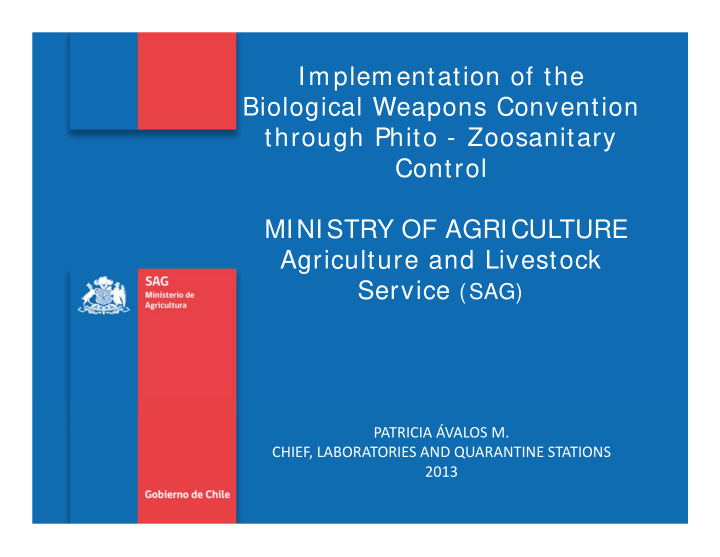



Implementation of the Biological Weapons Convention through Phito - Zoosanitary Control MINISTRY OF AGRICULTURE Subtitulo de la presentación en una línea Agriculture and Livestock Service (SAG) PATRICIA ÁVALOS M. CHIEF, LABORATORIES AND QUARANTINE STATIONS 2013
BIOLOGICAL WEAPONS CONVENTION IN CHILE NATIONAL AUTHORITY ADVISORY COUNCIL
SAG Plant and Animal Health Protection Agency Certification for Human Consumption of Export Primary Products Ministry of Health Food Safety SERNAPESCA Hydrobiological Products
NORTH: HORTICULTURE CAMELID RAISING ATACAM and ELQUI: FRESH FRUIT PRODUCTION GRAPE AND WINE-GROWING GOAT RAISING CENTRAL VALLEY: FRESH FRUIT AND HORTICULTURE WINE PRODUCTION ANNUAL CROPS (corn, wheat) CENTRAL SOUTH: ANNUAL CROPS/FRESH FRUIT WINE PRODUCTION MILK AND MEAT PRODUCTION FORESTRY (Pines and Eucalyptus) SOUTH: FRONTIER CEREALS MEAT PRODUCTION FORESTRY THE LAKES REGION: MILK AND MEAT PRODUCTION POTATO PRODUCTION FORESTRY EXTREME SOUTH: SHEEP AND CATTLE FORESTRY
Chile: based on production there are 7 macroregions
Free Trade Agreements Chile has trade access to 90% of the global gross domestic product EFTA EU (European Free Trade Association) (Island-Norway-Sitzerland- Liechtenstein) USA Canada Turkey China South Korea Mexico Japan Cuba El Salvador New Zeland Costa Rica Malasia Guatemala Brunei Panama Colombia Honduras Peru Uruguay Singapur Paraguay Argentina Australia Brazil Bolivia India Venezuela Ecuador
BIOSAFETY PEOPLE ANIMALS PLANTS ENVIRONMENT (OMS ‐ WHO) (OIE) (FAO) “ Analysis and risk management approach”
Chilean Agriculture and Livestock Service ( SAG) Mission : to protect and improve the productive and renewable natural resources from the agriculture and forestry sector of the country, as well as to ensure the agriculture food safety in order to support the sustainable and competitive sector development.
“To keep and improve the national plant and animal health situation to support the productive and exporting efforts of the country” • Surveillance and plant and animal health control • Border controls • Quarantine system • Diagnostic labs
Plant and anim al control m odel Risk analysis Update of global Risk product prohibition Previous information on Health Requirement border plagues and animal actions Global surveillance diseases Inspection and interception in Prevention of border controls exposure to plagues Border actions and and animal Quarantine/ Biosafety diseases Monitoring/ Inetrnal Early detection of biosafety/ Diagnosis plagues and animal Surveillance/ Health Education Later border diseases actions Elimination of plagues and Early response animal disease
Quarantine System • Admission requirements • Border controls (Strengthening Plan) • Quarantine after entrance • 30 dog teams
Num ber of Region X-Ray Machines Arica y 8 Parinacota Valparaíso 9 Araucanía 2 Los Lagos 1 Magallanes y 1 Antartica Chilena RM 6
Border Control System
LABORATORY AND AGRI CULTURE, LI VESTOCK AND QUARANTI NE STATI ONS DEPARTMENT Its main function is to make the necesary diagnosis and analyses in order to evaluate and certify the health situation and plant, animal and environment products.
Quarantine of Animals • Control and development of quarantines of mammals, birds and reptiles imported according to the current regulations and procedures.
Rodoluvio Animals Problem Incinerator Large Animals Administration Small Animal
SMALL ANIMALS • 8 ROOMS (HEPA filters, P° (-), T° controlled, air change 15/ hora) • Pets, reptils, exotic animals, ornamental birds.
LARGE ANIMALS • 4 CORRALS • 19 STALLS • Equines, Bovines, Camelids, Sheeps, Goats, Poultry, Zoo animals, etc.
Plant Quarantine Station OBJECTIVE To protect the national phytosanitary situation through absolute quarantine process. 20
LAB DEPARTMENT The Laboratory and Quarantine Station Department is made up of a national lab network (14) that have different specialties according to their geographical situation. The Department also has an external network of labs certified to develop activities required to support the SAG.
LAB NETWORK ARIC A L A SERENA L O AG UIRRE VAL PARAÍSO AMB AIRPO RT SAN ANT O NIO L O S ANDES C URIC Ó T AL C A C HIL L ÁN T EMUC O O SO RNO AYSÉN PT A. ARENAS
SAG ACHI EVEMENTS ERADICATION OF THE CLASSICAL SWINE FEVER ERADICATION OF FRUIT FLY AVIAN INFLUENZA OUTBREAK (H7N3) 2002 ERADICATION OF SIREX NOCTILIO SAG ERADICATION OF AVIAN INFLUENZA 2002 ERADICATION OF NEWCASTLE INSIGNIFICANT RISK OF BOVINE SPONGIFORM ENCEPHALOPATHY ERADICATION OF FOOT- AND-MOUTH DISEASE HOMALODISCA COAGULATA CONTROL IN ERADICATION OF EQUINE EASTER ISLAND INFECTIOUS ANAEMIA
CONCLUSI ONS • Currently, Chile is working on a twinning project with the OIE in relation to Newcastle and Aviar Influenza viruses. The objective is to increase lab security. • We keep an updated registry of all labs (universitis, private labs, etc.) handling risky strains. They must inform the SAG about their use and handling. • We have a biotechnology lab. • It belongs to BIOGIB group, an Iberoamerican group dedicated to Biosafety.
1. THE SCOPE OF THE CONVENTION 2. LAWS AND REGULATIONS 3. BIOLOGICAL MATERIAL AND RESEARCH 4. REGIONAL STRATEGY www.dgmn.cl
Thanks patricia.avalos@sag.gob.cl
Recommend
More recommend